《酒店服务英语》课程单元教学设计第3章project 3Banquet Service
- 格式:doc
- 大小:35.00 KB
- 文档页数:3
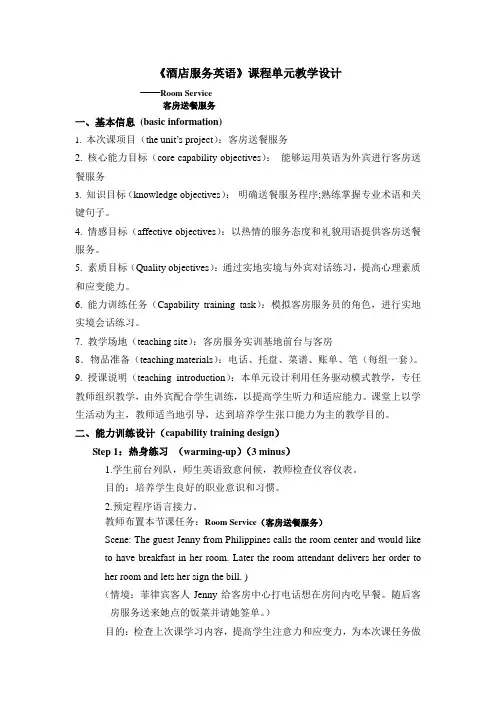
《酒店服务英语》课程单元教学设计——Room Service客房送餐服务一、基本信息(basic information)1. 本次课项目(the unit’s project):客房送餐服务2.核心能力目标(core capability objectives):能够运用英语为外宾进行客房送餐服务3. 知识目标(knowledge objectives):明确送餐服务程序;熟练掌握专业术语和关键句子。
4. 情感目标(affective objectives):以热情的服务态度和礼貌用语提供客房送餐服务。
5. 素质目标(Quality objectives):通过实地实境与外宾对话练习,提高心理素质和应变能力。
6. 能力训练任务(Capability training task):模拟客房服务员的角色,进行实地实境会话练习。
7.教学场地(teaching site):客房服务实训基地前台与客房8.物品准备(teaching materials):电话、托盘、菜谱、账单、笔(每组一套)。
9. 授课说明(teaching introduction):本单元设计利用任务驱动模式教学,专任教师组织教学,由外宾配合学生训练,以提高学生听力和适应能力。
课堂上以学生活动为主,教师适当地引导,达到培养学生张口能力为主的教学目的。
二、能力训练设计(capability training design)Step 1:热身练习(warming-up)(3 minus)1.学生前台列队,师生英语致意问候,教师检查仪容仪表。
目的:培养学生良好的职业意识和习惯。
2.预定程序语言接力。
教师布置本节课任务:Room Service(客房送餐服务)Scene: The guest Jenny from Philippines calls the room center and would like to have breakfast in her room. Later the room attendant delivers her order to her room and lets her sign the bill. )(情境:菲律宾客人Jenny给客房中心打电话想在房间内吃早餐。
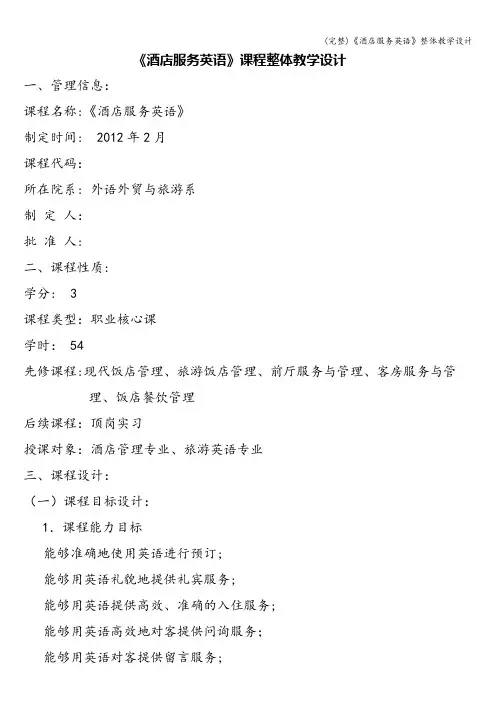
《酒店服务英语》课程整体教学设计一、管理信息:课程名称:《酒店服务英语》制定时间: 2012年2月课程代码:所在院系: 外语外贸与旅游系制定人:批准人:二、课程性质:学分: 3课程类型:职业核心课学时: 54先修课程:现代饭店管理、旅游饭店管理、前厅服务与管理、客房服务与管理、饭店餐饮管理后续课程:顶岗实习授课对象:酒店管理专业、旅游英语专业三、课程设计:(一)课程目标设计:1.课程能力目标能够准确地使用英语进行预订;能够用英语礼貌地提供礼宾服务;能够用英语提供高效、准确的入住服务;能够用英语高效地对客提供问询服务;能够用英语对客提供留言服务;能够用英语对客提供结账、外币兑换和贵重物品寄存服务;能够用英语对客提供叫醒、转接服务;能够用英语对客及时提供文秘、订票和翻译等服务;能够用英语灵活处理客人的投诉和各种突发事件;能够用英语完成对客的客房清理、租借物品、洗衣等服务;能够用英语礼貌得体地迎接客人;能够用英语完成点菜、酒水和席间服务;能够用英语准确高效地完成客房送餐服务2.课程知识目标能够了解前厅、客房、餐饮和其他部门各个岗位的工作职责;能够理解前厅、客房、餐饮和其他部门各个岗位的流程;能够准确理解上述各工作岗位的基本原则;能够准确识别上述各岗位的有关英语词汇;能够准确识记常见的英语句式句型;能够流利地组织常见的英语语句。
(二)学习模块设计模块一:前模块二:客房服务英语模块三:餐饮服务英语模块四:其他服务英语(四)进度表设计(以1节课为最小单元)模块一:前厅服务英语模块二:客房服务英语模块三:餐饮服务英语模块四:其他服务英语(五)第一节课设计梗概本次课标题:酒店服务英语课程导入步骤一宣布教学内容、目的介绍《酒店服务英语》的主要内容和编排,学完该书可能获得的知识和技能(能够用英语为外宾提供满意的服务);介绍该课程主要的实训项目.步骤二任务引导环节一:观看一个外宾在酒店住店、用餐和休闲的经历。
(通过此环节能够让学生了解整个酒店为外宾提供服务的流程)环节二:根据上述影像,学生以小组为单位探讨学习酒店服务英语的必要性和酒店服务英语有别于日常英语的地方.(通过此环节让学生能够初步体会酒店服务英语的特殊性,初步体会外语技能在全球化时代的重要性)步骤三学习活动方式介绍导入:观看往届学生课堂活动录像。
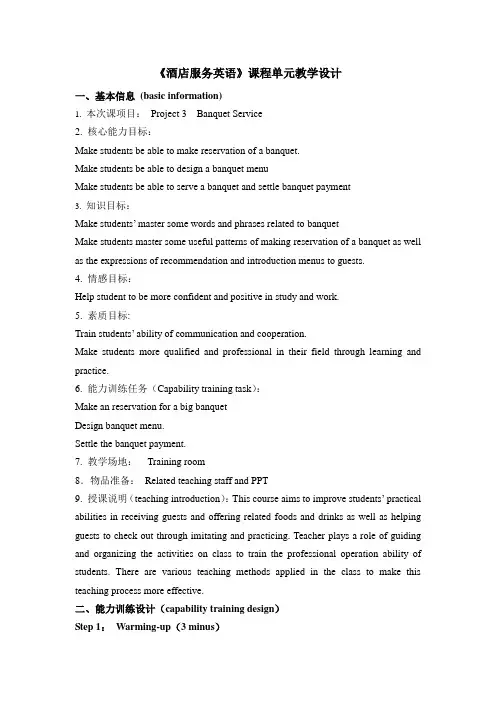
《酒店服务英语》课程单元教学设计一、基本信息(basic information)1. 本次课项目:Project 3 Banquet Service2.核心能力目标:Make students be able to make reservation of a banquet.Make students be able to design a banquet menuMake students be able to serve a banquet and settle banquet payment3. 知识目标:Make students’ master some words and phrases related to banquetMake students master some useful patterns of making reservation of a banquet as well as the expressions of recommendation and introduction menus to guests.4. 情感目标:Help student to be more confident and positive in study and work.5. 素质目标:Train students’ ability of communication and cooperation.Make students more qualified and professional in their field through learning and practice.6. 能力训练任务(Capability training task):Make an reservation for a big banquetDesign banquet menu.Settle the banquet payment.7.教学场地:Training room8.物品准备:Related teaching staff and PPT9. 授课说明(teaching introduction):This course aims to improve students’ practical abilities in receiving guests and offering related foods and drinks as well as helping guests to check out through imitating and practicing. Teacher plays a role of guiding and organizing the activities on class to train the professional operation ability of students. There are various teaching methods applied in the class to make this teaching process more effective.二、能力训练设计(capability training design)Step 1:Warming-up(3 minus)让学生说出大型的宴会组织需要注意哪些。
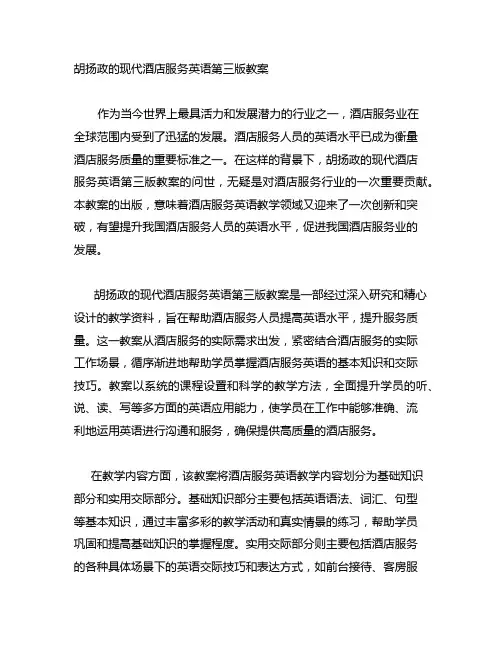
胡扬政的现代酒店服务英语第三版教案作为当今世界上最具活力和发展潜力的行业之一,酒店服务业在全球范围内受到了迅猛的发展。
酒店服务人员的英语水平已成为衡量酒店服务质量的重要标准之一。
在这样的背景下,胡扬政的现代酒店服务英语第三版教案的问世,无疑是对酒店服务行业的一次重要贡献。
本教案的出版,意味着酒店服务英语教学领域又迎来了一次创新和突破,有望提升我国酒店服务人员的英语水平,促进我国酒店服务业的发展。
胡扬政的现代酒店服务英语第三版教案是一部经过深入研究和精心设计的教学资料,旨在帮助酒店服务人员提高英语水平,提升服务质量。
这一教案从酒店服务的实际需求出发,紧密结合酒店服务的实际工作场景,循序渐进地帮助学员掌握酒店服务英语的基本知识和交际技巧。
教案以系统的课程设置和科学的教学方法,全面提升学员的听、说、读、写等多方面的英语应用能力,使学员在工作中能够准确、流利地运用英语进行沟通和服务,确保提供高质量的酒店服务。
在教学内容方面,该教案将酒店服务英语教学内容划分为基础知识部分和实用交际部分。
基础知识部分主要包括英语语法、词汇、句型等基本知识,通过丰富多彩的教学活动和真实情景的练习,帮助学员巩固和提高基础知识的掌握程度。
实用交际部分则主要包括酒店服务的各种具体场景下的英语交际技巧和表达方式,如前台接待、客房服务、餐饮服务等,通过模拟真实情景、角色扮演等活动,让学员在实践中掌握英语的真实应用能力,提高服务质量和工作效率。
教学方法方面,胡扬政的现代酒店服务英语第三版教案注重培养学员的主动学习能力和实际运用能力,采用多种互动教学手段,如小组讨论、角色扮演、案例分析等,激发学员的学习兴趣,培养学员的团队合作意识和实际应用能力。
教师在教学过程中扮演引导者和组织者的角色,注重激发学员的学习积极性和主动性,遵循“由表及里、由浅入深”的原则,循序渐进地指导学员掌握酒店服务英语的相关知识和技能。
教学效果方面,根据教案设计者的介绍和实际应用情况来看,胡扬政的现代酒店服务英语第三版教案在提高学员英语水平和服务质量方面取得了显著成效。





酒店服务英语projectbuffetandcoffee shopservicexx年xx月xx日CATALOGUE 目录•introduction•buffet restaurant service•coffee shop service•buffet and coffee shop service comparisonCATALOGUE目录•buffet and coffee shop service qualityassurance•conclusion01 introductionbackground information01Development of English language skills in the hospitality industry02Importance of communication and language skills in hotels03Buffet and coffee shop service as important elements of hotel serviceaims and objectivesImproving English communicationskills in hotel buffet and coffeeshop service 要点一要点二Understanding the needs and preferences of foreign guests Effectively promoting buffet and coffee shop services to foreign guests 要点三How to effectively communicate with foreign guests in hotel buffet and coffee shop service?research questionWhat are the main difficulties and challenges encountered in the process of providing service inEnglish?How to improve English language skills in the hospitality industry?02buffet restaurant serviceoffering mainly Chinese disheswith self-service for customers tohelp themselves to the food they want.types of buffet restaurant a combination of breakfast and lunch buffets, providing a variety of breakfast items and lunch options.Chinese buffetBuffet restaurant Buffet brunchbuffet restaurant etiquetteIt is necessary to queue up for food and payfirst.buffet restaurant management010*******The store should beclean and tidy, withsufficient table spaceand seats.03coffee shop servicetypes of coffee shops休闲咖啡店通常提供各种口味和类型的咖啡、茶和点心,设有舒适的座位和休闲氛围,适合放松休息。

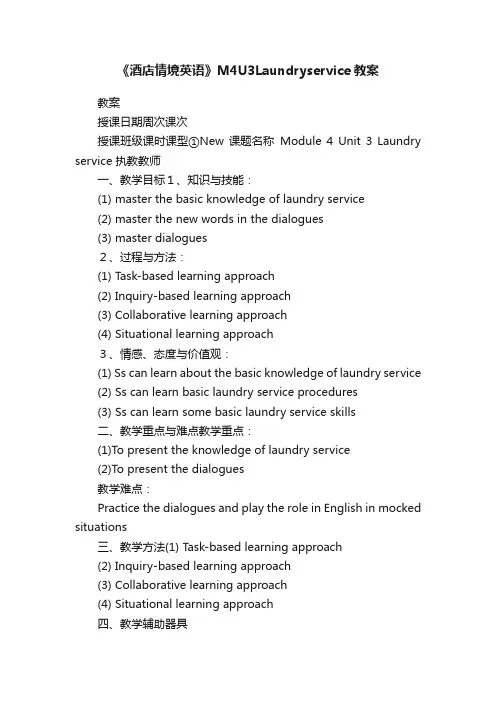
《酒店情境英语》M4U3Laundryservice教案教案授课日期周次课次授课班级课时课型①New 课题名称Module 4 Unit 3 Laundry service 执教教师一、教学目标1、知识与技能:(1) master the basic knowledge of laundry service(2) master the new words in the dialogues(3) master dialogues2、过程与方法:(1) Task-based learning approach(2) Inquiry-based learning approach(3) Collaborative learning approach(4) Situational learning approach3、情感、态度与价值观:(1) Ss can learn about the basic knowledge of laundry service(2) Ss can learn basic laundry service procedures(3) Ss can learn some basic laundry service skills二、教学重点与难点教学重点:(1)To present the knowledge of laundry service(2)To present the dialogues教学难点:Practice the dialogues and play the role in English in mocked situations三、教学方法(1) Task-based learning approach(2) Inquiry-based learning approach(3) Collaborative learning approach(4) Situational learning approach四、教学辅助器具Books, multi-media, chalk. Blackboard五、教学过程1 Lead-in:1)ReviewWhat are the procedures of cleaning rooms?Ask the students to play the roles2)Look and match:T-shirt gloves coat scarf jacket tieskirt shorts vest blouse sweater trousers1scarf2. tie3. gloves4 skirt5. trousers6. sweater7. coat8. vest9. jacket10. T-shirt11. shorts12. blouse3)Keep these important tips in mind when serving: Knock at the door.Greet the guest and ask if the guest has some laundry. Ask the guest to fill in the laundry list.Make some explanations if necessary.Tell the guest when he can get back his clothes. Answer any question from the guest.Say goodbye politely.2. Pre-task:1. Good morning. I’m here to collect your laundry.早上好。
《酒店服务英语》课程单元教学设计——Turn-down Service and Extending an Extra Bed开夜床和加床服务一、基本信息(basic information)1. 本次课项目(the unit’s project):开夜床服务2.核心能力目标(core capability objectives):能够运用英语为外宾进行开夜床服务3. 知识目标(knowledge objectives):明确开夜床的服务程序;熟练掌握专业术语和关键句子。
4. 情感目标(affective objectives):以热情的服务态度和礼貌用语提供开夜床服务。
5. 素质目标(Quality objectives):通过实地实境与外宾对话练习,提高心理素质和应变能力。
6. 能力训练任务(Capability training task):模拟客房服务员的角色,进行实地实境会话练习。
7.教学场地(teaching site):客房服务实训基地前台与客房8.物品准备(teaching materials):”请勿打扰”牌、托盘、笔(每组一套)。
9. 授课说明(teaching introduction):本单元设计利用任务驱动模式教学,专任教师组织教学,由外宾配合学生训练,以提高学生听力和适应能力。
课堂上以学生活动为主,教师适当地引导,达到培养学生张口能力为主的教学目的。
二、能力训练设计(capability training design)Step 1:热身练习(warming-up)(3 minus)1.学生前台列队,师生英语致意问候,教师检查仪容仪表。
目的:培养学生良好的职业意识和习惯。
2.预定程序语言接力。
教师布置本节课任务:Turn-down Service(开夜床服务)Scene: The guest Jenny from Philippines would like the room attendant to do the turn-down service one hour later because she is busy with her work. The room attendant replaces the used cups and towels with new ones in the bathroom.)(情境:菲律宾客人Jenny因忙于工作,希望服务员1小时候来开夜床。
酒店服务英语教案教案标题:酒店服务英语教案教案目标:1. 学习和掌握与酒店服务相关的英语词汇和表达。
2. 培养学生在酒店服务场景中的英语沟通能力。
3. 提高学生对酒店服务行业的了解和兴趣。
教学重点:1. 掌握常用的酒店服务英语词汇和表达。
2. 学会在不同情境下运用英语进行酒店服务交流。
3. 培养学生的听说能力和沟通技巧。
教学准备:1. 酒店服务相关的图片、海报或PPT。
2. 酒店服务场景对话录音或视频素材。
3. 学生练习册或工作纸。
教学步骤:引入:1. 展示一些酒店服务相关的图片或海报,引起学生对酒店服务的兴趣。
2. 向学生提问,了解他们对酒店服务的了解程度,并激发他们的思考。
词汇学习:1. 教师介绍和解释常用的酒店服务英语词汇,如check-in, check-out, reservation, room service等。
2. 学生跟读和模仿教师的发音,加深对词汇的记忆。
对话练习:1. 教师播放酒店服务场景对话录音或视频素材,让学生先听一遍。
2. 学生分组进行角色扮演,模仿对话中的情景和表达,练习对话。
情景模拟:1. 将学生分成小组,每个小组扮演酒店服务员和顾客的角色。
2. 给每个小组分发一个情景卡片,上面写有特定的酒店服务场景,如办理入住手续、提供房间服务等。
3. 学生根据情景卡片进行角色扮演,练习在实际情境中运用英语进行酒店服务交流。
总结:1. 教师对学生的表现进行评价和总结,肯定他们的努力和进步。
2. 回顾本课所学的酒店服务英语词汇和表达,巩固学生的记忆。
拓展活动:1. 鼓励学生到附近的酒店进行实地考察,观察和体验酒店服务场景,并用英语描述自己的观察和体验。
2. 布置相关的写作任务,要求学生以酒店服务为主题,撰写一篇英语作文,分享自己对酒店服务的看法和建议。
教学反思:1. 教师对本节课的教学效果进行评价和反思,分析学生的表现和问题,并进行相应的调整和改进。
2. 收集学生的反馈意见,了解他们对本节课的学习体验和收获,以便进一步优化教学设计。
《酒店服务英语》课程单元教学设计
一、基本信息(basic information)
1. 本次课项目:Project 3 Banquet Service
2.核心能力目标:
Make students be able to make reservation of a banquet.
Make students be able to design a banquet menu
Make students be able to serve a banquet and settle banquet payment
3. 知识目标:
Make students’ master some words and phrases related to banquet
Make students master some useful patterns of making reservation of a banquet as well as the expressions of recommendation and introduction menus to guests.
4. 情感目标:
Help student to be more confident and positive in study and work.
5. 素质目标:
Train students’ ability of communication and cooperation.
Make students more qualified and professional in their field through learning and practice.
6. 能力训练任务(Capability training task):
Make an reservation for a big banquet
Design banquet menu.
Settle the banquet payment.
7.教学场地:Training room
8.物品准备:Related teaching staff and PPT
9. 授课说明(teaching introduction):This course aims to improve students’ practical abilities in receiving guests and offering related foods and drinks as well as helping guests to check out through imitating and practicing. Teacher plays a role of guiding and organizing the activities on class to train the professional operation ability of students. There are various teaching methods applied in the class to make this teaching process more effective.
二、能力训练设计(capability training design)
Step 1:Warming-up(3 minus)
让学生说出大型的宴会组织需要注意哪些。
目的:明确宴会服务的注意事项。
Step 2:Leading-in the project(2 minus)
教师布置本节课任务:(为客人提供宴会预订及安排服务)
情境:向客人介绍餐厅的特色宴会服务。
Step 3: Practice --Students’trying to work out a dialogue by themselves (8 minus)
挑出两名左右同学进行宴会服务介绍并展示宴会服务的特点。
目的:通过学生的模拟过程让其联系实际工作经验,丰富英语表达能力,体现了建构主义学习观。
Step 4:Teachers’ demonstrating and explaining(10 minus)
1.引导学生讨论归纳为宴会服务的程序及注意事项。
2.教师模拟宴会预定的流程。
3.学生认真听、认真观察。
4.讲解关键句子,使学生掌握多种表达方式。
预定: Banquet service. May I help you?
When would you like to have the banquet?
How many people will come to the banquet?
Here is the banquet menu. How much would you like to spend for each
table?
What drinks would you prefer?
Do you have any special requirements?
We’ll get it ready before the b anquet.
How much would you like to spend for each person?
Step 5:Students’ mocking practice in groups with the teachers’ guide(5minus)目的:体会角色,进一步巩固宴会预定的相关问题,训练张口能力和应变能力。
任务一:练习掌握关键句子
学生两人一组,互换角色进行会话练习,掌握关键句子。
任务二:程序训练
利用真实场景,分角色与外宾模拟对话,
教师巡回点拨、指导;教师根据发现的问题集中讲解,学生再对话练习。
Step 6:Class demonstration and feedback control(10 minus)
目的:学生体验成果,进一步发现问题,明确努力方向。
分别请几位学生模拟预定宴会情境;师生共同观察;
师生共同点评,指出存在问题,尤其是表情、眼神、动作等具体细节
与表达方式,力争使学生会用规范的服务,并注意语气的运用,进一明确目标。
Homework(5 minus)
同学课后继续练习办理离店手续的对话,熟练掌握点餐服务程序和关键语句。
自行补充关于餐厅用餐服务的其它相关内容,如(点菜等)。